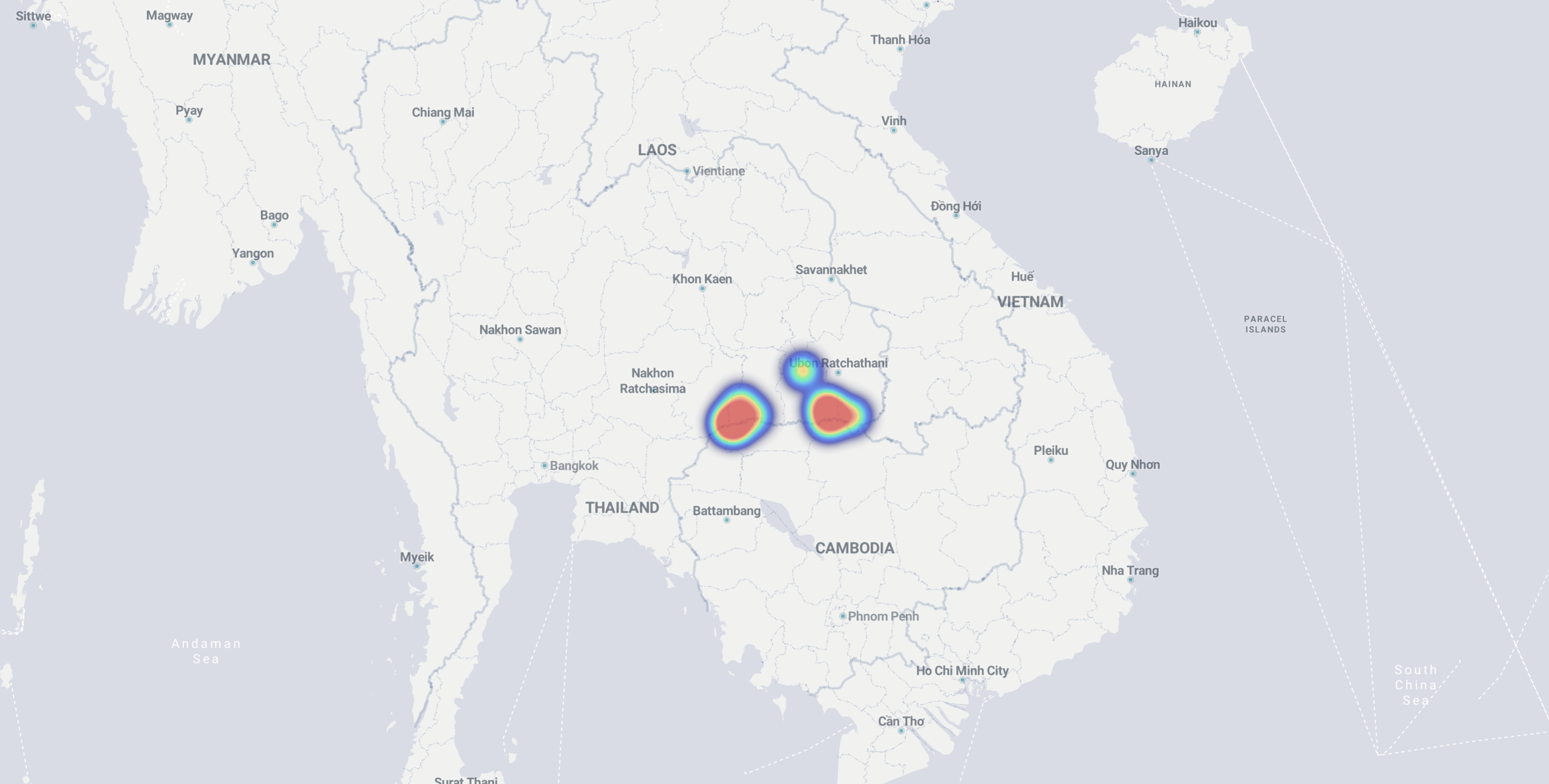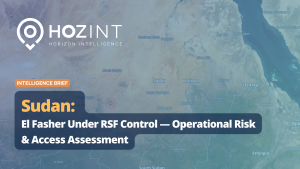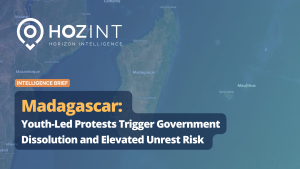DOWNLOAD PDF
Key Points
-
Clashes between Thai and Cambodian troops on 24 July 2025 have killed at least 12, mostly civilians, and displaced over 40,000 people.
-
The confrontation reignited a century-old territorial dispute surrounding the 11th-century Preah Vihear temple, with both sides accusing each other of initiating the violence.
-
Thailand conducted airstrikes after Cambodian forces allegedly launched rocket attacks, with both nations escalating military deployments and economic restrictions.
-
Domestic political instability and weak leadership in both countries risk prolonging the conflict.
-
Forecast: A full-scale war is unlikely, but recurrent skirmishes and diplomatic stalemates may persist due to entrenched historical grievances and political calculus.
Event Summary
Who: The conflict involves the armed forces of Thailand and Cambodia, with civilians also bearing the brunt of casualties. Thai Prime Minister Phumtham Wechayachai and Cambodian Prime Minister Hun Manet are the respective political leaders managing the crisis.
What: A new round of armed clashes broke out on 24 July 2025 at the disputed border near the Preah Vihear temple area. Thai authorities report 12 deaths (11 civilians and 1 soldier), while Cambodia has not confirmed its own casualty numbers. Both sides claim the other provoked the incident.
Where: Clashes occurred near the Khmer-Hindu Preah Vihear temple, which lies on the Cambodia-Thailand border, particularly affecting Thailand’s Surin, Ubon Ratchathani, and Srisaket provinces.
When: The latest escalation began in the early hours of 24 July 2025, following months of rising tension since a May skirmish that left one Cambodian soldier dead.
Why: The root cause is a disputed claim over the Preah Vihear temple. Cambodia registered it as a UNESCO World Heritage Site in 2008, which Thailand contested. This revived historic border disagreements dating back to French colonial demarcations over a century ago.
How: The clash reportedly began with Cambodian drone surveillance, prompting Thai troops to retaliate. Cambodia alleges Thai forces violated prior agreements by moving toward the temple. Fighting rapidly escalated into rocket fire from Cambodia and Thai airstrikes, resulting in both civilian and military casualties.

Analysis
This border conflict is emblematic of long-standing nationalist tensions in Southeast Asia, with both countries leveraging historical grievances for domestic political gain.
Historical Context
The origins of the Cambodia–Thailand border conflict lie in colonial cartography and post-independence ambiguity. The Preah Vihear temple, an 11th-century Khmer Hindu structure, lies atop a cliff in the Dângrêk Mountains near the present-day border. It was awarded to Cambodia by a 1962 International Court of Justice (ICJ) ruling. However, that judgment did not clearly define sovereignty over the surrounding 4.6 km² of land adjacent to the temple—creating a sovereignty vacuum.
During the French colonial period, maps prepared by French surveyors placed the temple inside Cambodian territory. Thailand (then Siam), while accepting French maps at the time, later disputed their legitimacy, arguing they were not mutually ratified.
Tensions remained dormant for decades but reignited in 2008, when Cambodia applied to UNESCO to list Preah Vihear as a World Heritage Site. Thailand saw this as a de facto claim to the disputed land. The resulting domestic backlash—particularly from Thai nationalist groups and the military—ignited a series of military skirmishes from 2008 to 2011, including shelling and brief occupations. Sporadic violence has since erupted during periods of political instability in either country.
Notably, both nations have used the issue to rally nationalist support, especially during election periods or domestic crises. The Cambodian People’s Party (CPP) under Hun Sen (and now his son Hun Manet) has repeatedly invoked national sovereignty over Preah Vihear. Similarly, various Thai governments, especially those with military backing, have framed the dispute in terms of Thai territorial integrity and resistance to foreign encroachment.
The temple’s symbolic and strategic importance—positioned on high ground, offering a tactical military advantage—makes it more than just a cultural landmark. It is both a military outpost and a nationalist rallying point.
Military Developments
The recent July 2025 clashes represent the most significant escalation since 2011, with both countries deploying increasingly sophisticated military assets:
-
Thailand’s air force carried out precision airstrikes targeting Cambodian troop positions near the border. This marks a departure from previous skirmishes which were largely artillery-based and fought at platoon scale. The use of air power suggests a doctrine shift toward assertive deterrence and rapid force projection.
-
Cambodia reportedly launched multiple rocket salvos into Thai territory. These included shoulder-fired and possibly mobile artillery systems, indicating pre-planned retaliatory capabilities rather than spontaneous escalation.
-
Thai officials claimed that Cambodian surveillance drones flew over Thai military positions—interpreted as a provocation. If accurate, this shows Cambodia’s adoption of unmanned aerial reconnaissance, likely sourced from China or other regional suppliers, pointing to military modernisation.
-
Both sides have now reinforced troop deployments. Cambodia has reportedly moved mechanised infantry units and anti-air systems to border outposts in Oddar Meanchey and Preah Vihear provinces. Thailand, meanwhile, has mobilised elements from its Second Army Region, which traditionally handles northeastern border security.
-
A logistics build-up is also visible, with satellite images showing new tent encampments, artillery emplacements, and reinforced observation posts along both sides of the border. This suggests a protracted military stand-off is likely in the coming months.
-
Information warfare also appears to be playing a role: each side has released competing narratives on social media and state media, accusing the other of aggression and treaty violation. These campaigns aim to solidify domestic support and international legitimacy.
Border Closures and Travel Advisories
In response to the hostilities, Thailand has sealed several official crossings into Cambodia, including those in Surin, Srisaket, and Ubon Ratchathani provinces, affecting thousands of daily cross-border traders and migrant workers. Checkpoints such as Chong Chom (Surin) and Chong Sa-Ngam (Srisaket) are either closed or operating under strict military supervision.
Cambodia, for its part, has retaliated with economic countermeasures, including:
-
Suspending imports of Thai agricultural products, including fruits and vegetables.
-
Halting purchases of electricity and internet services from Thai providers, which has affected border communities reliant on Thai infrastructure.
The impact on civilians has been profound:
-
Over 40,000 Thais have been evacuated from the conflict-affected areas, according to the Thai military. Temporary camps have been set up with basic provisions, though local reports cite overcrowding and insufficient medical care.
-
Cambodian civilians near the border have been urged to relocate inland, although casualty numbers from the Cambodian side remain undisclosed, raising concerns about transparency and possible underreporting.
International travel advisories have begun to reflect the situation:
-
The U.S. Department of State and UK Foreign Office have issued Level 3 “Reconsider Travel” advisories for border regions, citing the risk of shelling, unexploded ordnance, and military checkpoints.
-
Regional airlines have re-routed some domestic and low-altitude international flights that typically fly near the border corridor.
-
Tourism to the Preah Vihear temple, once a modest draw for regional visitors, has now completely halted. UNESCO has expressed concern over potential damage to a World Heritage Site, as seen in previous clashes in 2011 when artillery damaged parts of the temple.
The economic fallout from prolonged border closure could significantly affect border economies. Informal cross-border trade—which supports tens of thousands of rural Thais and Cambodians—has ground to a halt. This may drive increased smuggling, economic hardship, and local resentment that both governments could struggle to contain.
Forecast and Implications
-
Short-term: Although the current round of violence may temporarily de-escalated, the situation remains volatile. Further border skirmishes, miscalculated provocations, or accidental engagements remain likely.
-
Medium-term: Given both sides’ fragile political leadership and nationalist sentiment, a sustainable diplomatic resolution is improbable without third-party mediation, possibly by ASEAN or the UN. The lack of clear demarcation, compounded by ambiguous ICJ interpretations, ensures the territorial dispute will remain a flashpoint.
-
Long-term: Unless both governments can internalise the political cost of conflict and prioritise regional stability, the area risks becoming a chronic low-intensity conflict zone akin to other unresolved post-colonial boundaries (e.g., India-Pakistan over Kashmir, Eritrea-Ethiopia pre-2000).
-
Regional Repercussions: Escalation threatens to destabilise Mekong regional cooperation and ASEAN cohesion, especially if nationalism spills over into other regional disputes like South China Sea claims. External actors such as China may exploit the instability to deepen economic or strategic influence in both countries.
Conclusion
The renewed Thailand-Cambodia border clashes are not an isolated incident but part of a pattern of nationalist revivalism and unresolved post-colonial borders in Southeast Asia. While unlikely to lead to full-scale war, the conditions—weak leadership, mutual distrust, and historical grievance—mean this conflict will likely persist as a destabilising force unless diplomatically addressed. The next flashpoint may not be far off.



